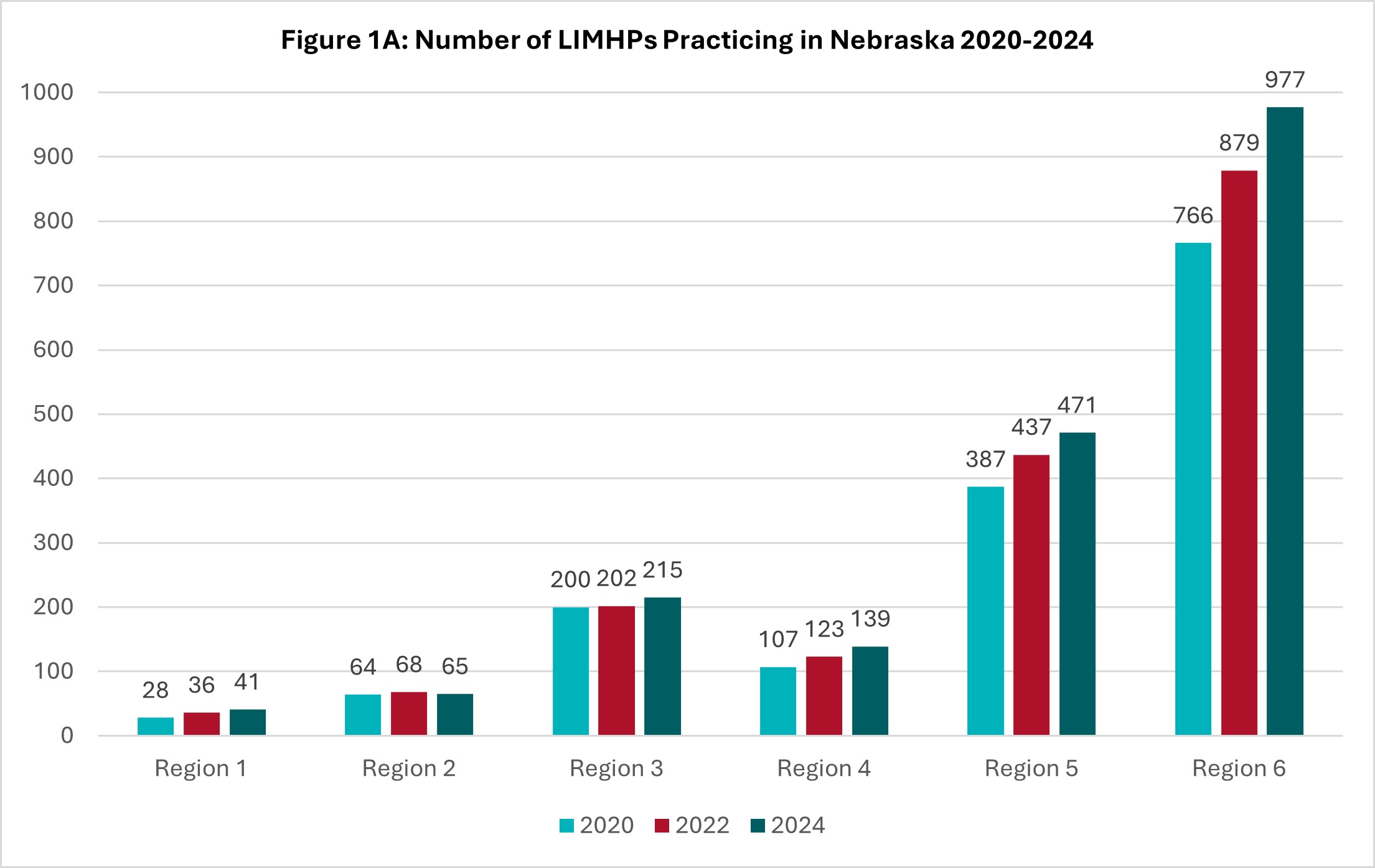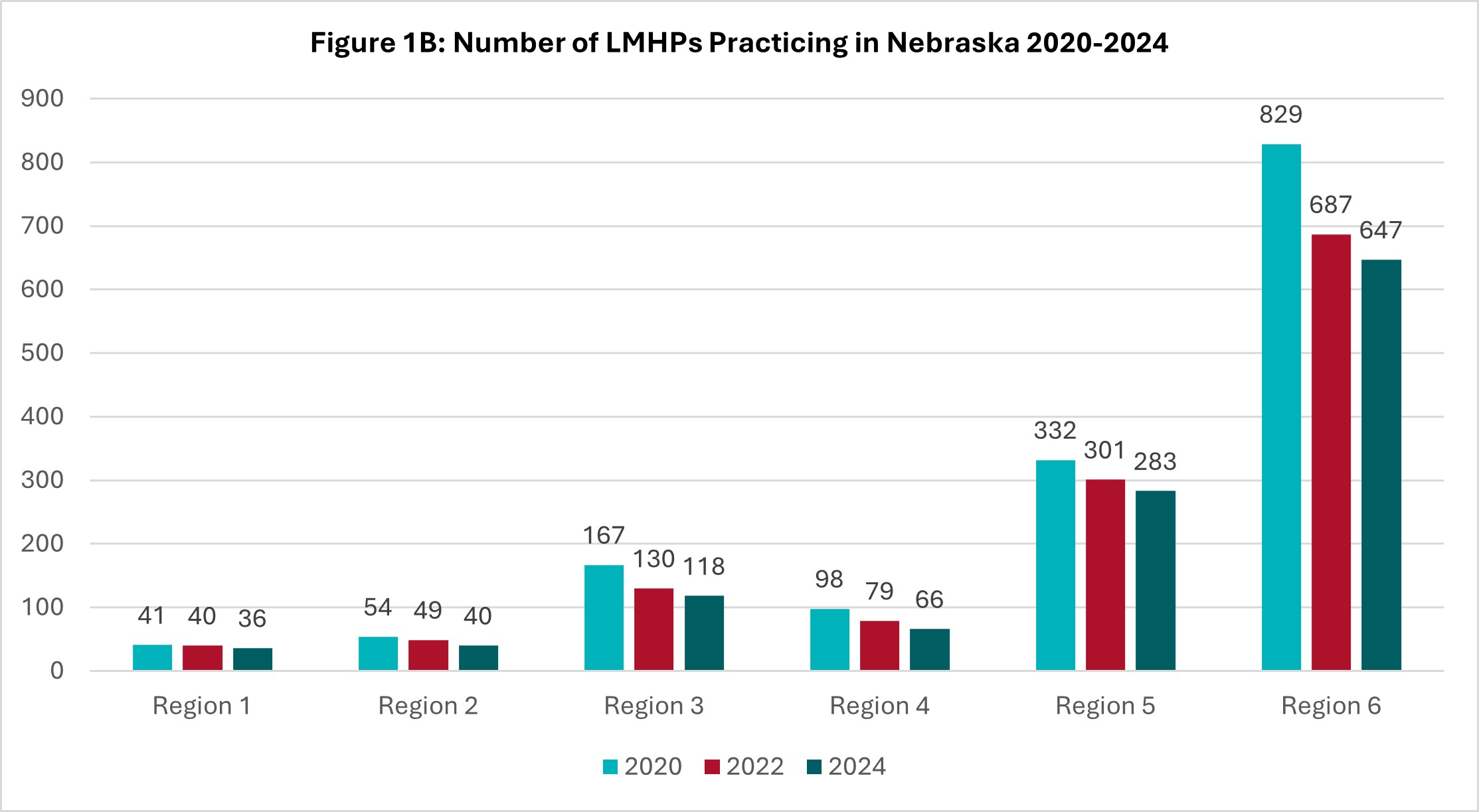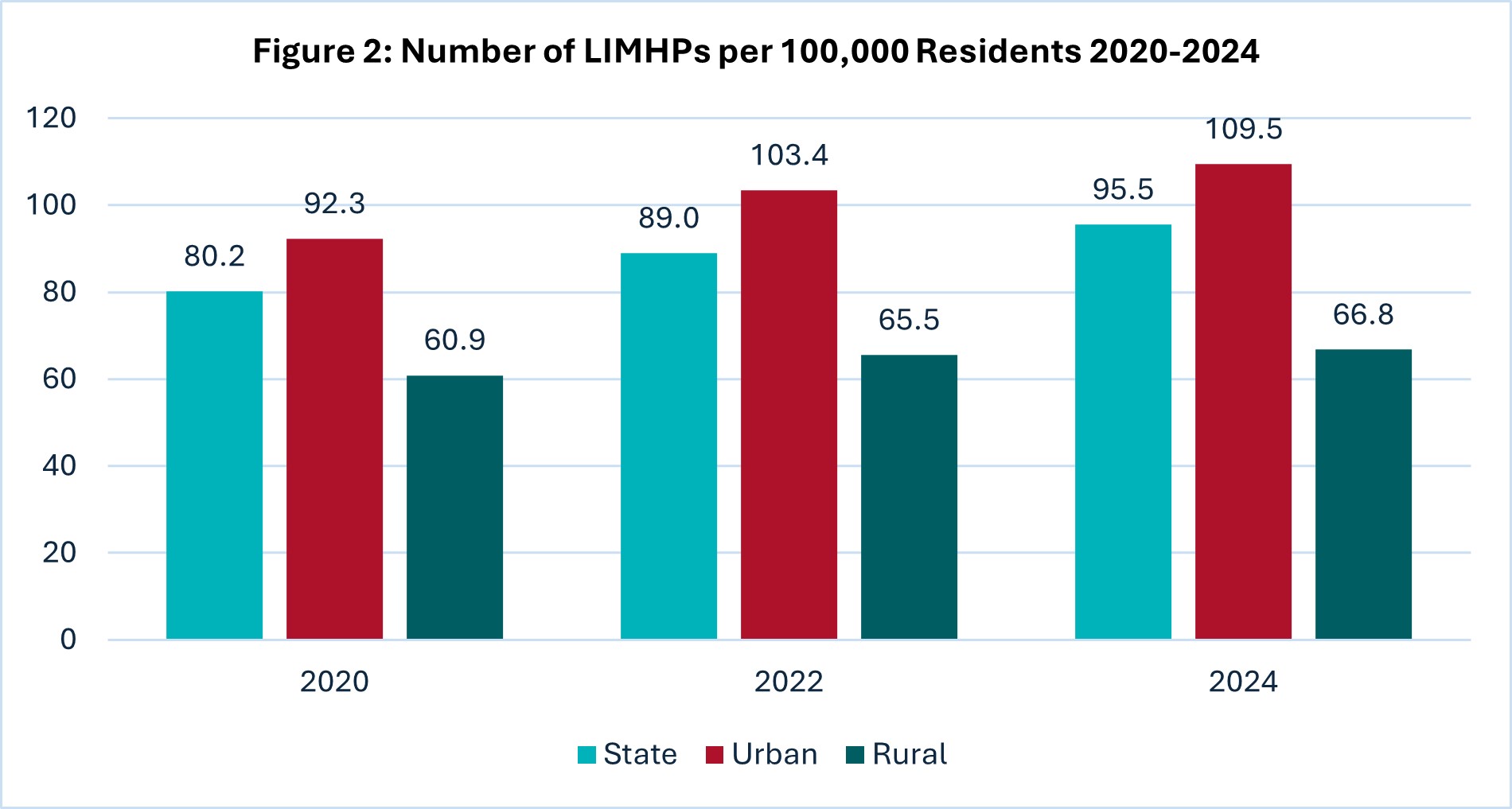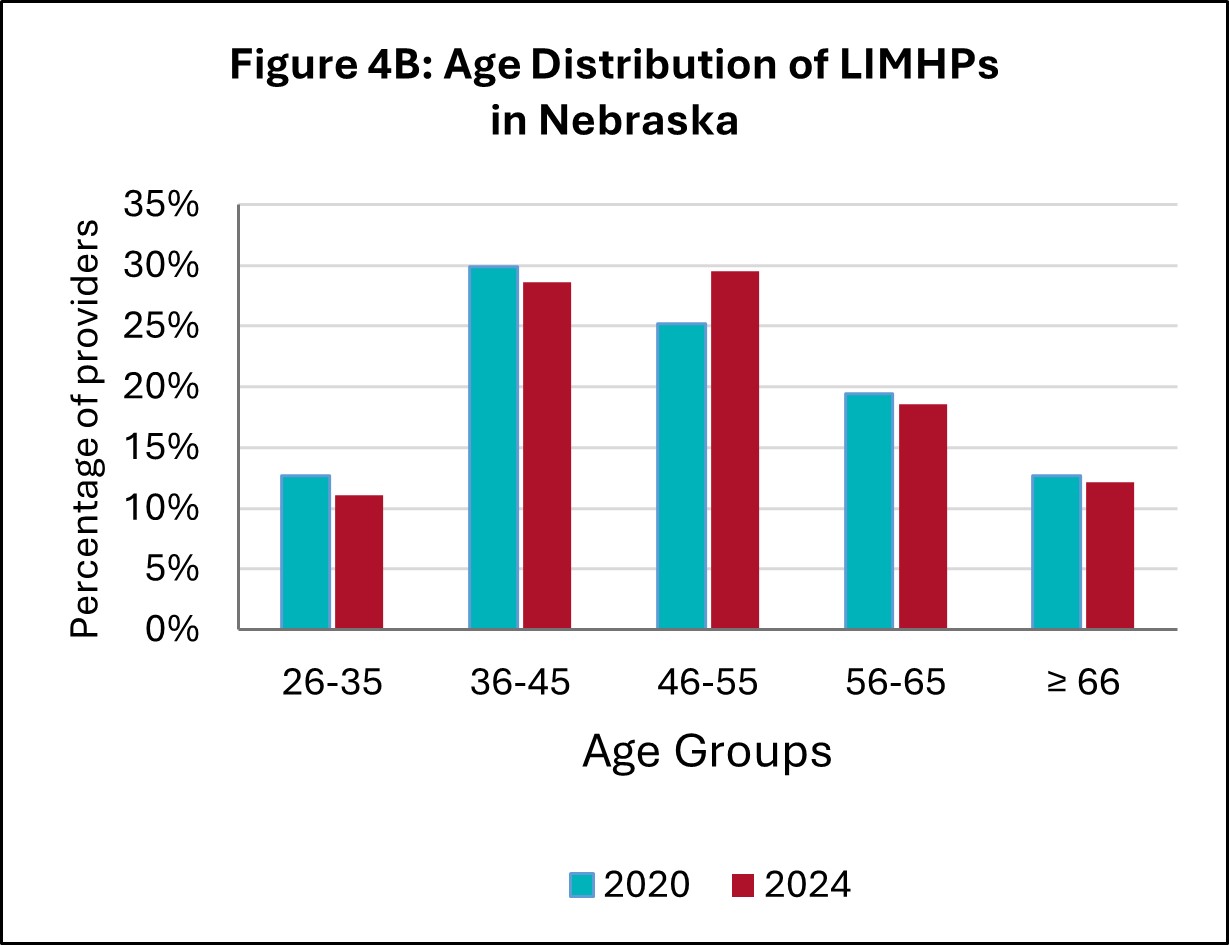The Licensed & Licensed Independent Mental Health Practitioner Workforce in Nebraska: 2020 to 2024
Purpose
BHECN utilizes data from the UNMC Health Professions Tracking Service to determine the number and type of licensed behavioral health professionals who practice in Nebraska. This data snapshot includes information about the Licensed Mental Health Practitioner (LMHP) and Licensed Independent Mental Health Practitioner (LIMHP) workforce from 2020 to 2024.
A LMHP/LIMHP creates purposeful relationships that empower diverse individuals, couples, families, children, adolescents, and groups to achieve mental health, wellness, educational, and career goals. They apply mental health, psychological, human development, or family systems principles and interventions to help clients adjust their thoughts, feelings or actions. They also diagnose and treat mental and emotional disorders, such as anxiety and depression. LIMHPs may practice more independently and diagnose and treat major mental illnesses or disorders without supervision or consultation, while LMHPs must consult with a LIMHP, qualified physician, or licensed clinical psychologist to diagnose and treat conditions that fall under major mental illness.
Key Findings
- The Nebraska LIMHP workforce grew by 24% from 2020 to 2024, while the LMHP workforce decreased by 21% over the same period.
- The increased LIMHP and decreased LMHP numbers appear to reflect a conversion to independent licensure among Nebraska practitioners.
- The number of LIMHPs increased in five of the six Nebraska Behavioral Health Regions, while the number of LMHPs decreased in all Regions.
- Rural areas still have fewer LMHPs and LIMHPs than urban areas of the state.
- Nebraska has mental health practitioner educational programs in five of the six Regions.
Regional Trends
The number of licensed LIMHPs practicing in Nebraska increased 24% from 2020 to 2024 (from 1552 to 1916). The number of LIMHPs increased in all but one of the Nebraska Behavioral Health Regions as well (see Figure 1A).[1]

The number of licensed LMHPs practicing in Nebraska decreased 21% from 2020 to 2024 (from 1524 to 1200). The number of LMHPs decreased in all Regions (see Figure 1B).
These changes (decreased LMHPs and increased LIMHPs) appear to reflect a trend toward more providers qualifying and converting to independent licensure.

Rural and Urban Distribution of LIMHPs
The number of LIMHPs in both urban and rural areas of Nebraska increased from 2020 to 2024 (see Figure 2). However, the number of LIMHPs per 100,000 residents is still below the national average of 129 practitioners per 100,000 population.[2]

The number of practitioners per 100,000 residents is significantly lower in rural areas of Nebraska compared to urban areas: about half as many (55%) LMHPs and about 2/3 as many (61%) LIMHPs per 100,000 residents (see Figure 3).

Age of LMHPs and LIMHPs
Since 2020, the number of LMHPs and LIMHPs both entering the workforce and at or nearing retirement age has decreased slightly, and the number of LMHPs and LIMHPs aged 46-55 has increased (see Figures 4A & B).


LMHP/LIMHP Training Programs
There are various education programs that lead to a career as a mental health practitioner, but all LMHP/LIMHPs are required to obtain an undergraduate degree and a Master’s degree or equivalent in a mental health-related field. This process typically takes 6-8 years, consisting of 4 years to complete a Bachelor’s degree and 2-4 years for the Master’s degree.
There are nine institutions of higher education in Nebraska that offer a Master’s degree in Social Work, Clinical Mental Health Counseling, or Marriage & Family Therapy, leading to mental health practitioner licensure: Chadron State College (Region 1 - online); University of Nebraska Kearney (Region 3); Wayne State College (Region 4); Doane University, Concordia University, Nebraska Wesleyan University, and University of Nebraska Lincoln (Region 5); and Bellevue University, Crown College, and University of Nebraska Omaha (Region 6). Individuals with a Master’s in Psychology who are enrolled in a doctoral program accredited by the American Psychological Association are also eligible for licensure as a mental health practitioner. There are two such programs in Nebraska, both at the University of Nebraska-Lincoln.
Although the mental health practitioner workforce is supported by the large number of graduate programs in Nebraska, they still face known challenges on the path to graduation and licensure. Master’s programs require intensive applied training experiences such as practica and internships that are often unpaid. Students with other employment and commitments are forced to make difficult choices about how and when to complete these requirements. Further, licensed professionals must decide whether to supervise students, as providing quality supervision is time-consuming and often cost-prohibitive.
Graduates of approved programs can apply to become provisionally licensed (PLMHP) and then become fully licensed as an LMHP after completing 3,000 hours of supervised experience in mental health practice in Nebraska. PLMHPs or LMHPs can apply to be LIMHPs if they have 1,500 hours of psychotherapy experience with individuals having major mental or emotional disorders under the supervision of a qualified supervisor. Findings from BHECN’s Nebraska Health Workforce Partnership (NEBWP) 2025 Summit[3] indicate that provisionally licensed providers and their supervisors need additional financial support to address supervision, licensing, and credentialing challenges.
Conclusions
The LIMHP workforce has grown in five of six Behavioral Health Regions across Nebraska since 2020. The concurrent reduction in the number of LMHPs most likely represents conversion to the independent license, thus offering patients across the state practitioners who are prepared to practice at a higher level with less oversight and constraints. The availability of LIMHPs remains higher in urban areas compared to rural areas, and the number of providers per 100,000 residents is lower than the national average. Nebraska has strong mental health practitioner educational programs in nearly every Behavioral Health Region. Overall, these findings highlight positive changes in the Nebraska LIMHP workforce along with the need for continued efforts to ensure the positive trends continue.
Suggested citation:
Behavioral Health Education Center of Nebraska. (2025). The Licensed & Licensed Independent Mental Health Practitioner Workforce in Nebraska: 2020 to 2024.
https://www.unmc.edu/bhecn/research-data-policy/2020_2024_lmhplimhp_snapshot.html
Footnotes
[1] Nebraska Department of Health & Human Services, Division of Behavioral Health. Behavioral Health Resources for Schools https://dhhs.ne.gov/BHSchoolResources/AboutDBH.pdf
[2] U.S. Bureau of Labor Statistics. Occupational Employment and Wage Statistics Query System. https://data.bls.gov/oes/#/occGeo/One%20occupation%20for%20multiple%20geographical%20areas
[3] BHECN (2025). Nebraska Behavioral Health Workforce Partnership Summit 2025 Report.